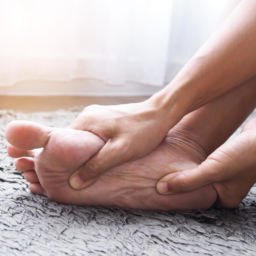
Sciatica, often characterized by a sharp, shooting pain that radiates down one leg, is caused by irritation or compression of the sciatic nerve. The sciatic nerve, which runs from the lower back, through the hips, and down each leg, can become inflamed due to conditions such as herniated discs, muscle imbalances, or piriformis syndrome.
Stretching exercises can provide significant relief for sciatica pain by reducing nerve pressure, improving flexibility, and strengthening the muscles surrounding the sciatic nerve. In this blog, we’ll explore effective sciatic nerve stretches that can help alleviate nerve pain, as well as provide a guide on how to treat sciatica with proper exercises.
What is the Sciatic Nerve?
Before we dive into the stretches, it’s essential to understand the sciatic nerve’s role in your body. The sciatic nerve is the largest nerve in the body, running from the lower back through the glutes and down the back of the legs. Sciatica pain occurs when the nerve becomes compressed or irritated, leading to pain, tingling, or numbness that can travel down the leg. This discomfort can be caused by various factors, such as muscle spasms, herniated discs, or inflammation around the piriformis muscle, which can press against the sciatic nerve.
The Role of the Piriformis Muscle in Sciatica
One common culprit in sciatic nerve pain is the piriformis muscle. Located deep in the glute region, the piriformis helps stabilize the hip and assist with leg rotation. However, when this muscle becomes tight or inflamed (a condition known as piriformis syndrome), it can irritate or compress the sciatic nerve, causing discomfort and sciatica symptoms. Piriformis syndrome can be treated effectively through targeted stretching exercises that relax and lengthen the piriformis muscle.
Effective Sciatic Nerve Stretches

1. Piriformis Stretch
This stretch helps to target the piriformis muscle, which can alleviate pressure on the sciatic nerve.
- Starting Position: Lie flat on the floor with your knees bent and feet flat on the ground.
- Action: Place your right ankle on top of your left knee, creating a figure-four shape. Slowly draw your left knee toward your chest, feeling a gentle stretch. Hold the position for 30 seconds, then carefully release and switch to the other side.
- Tip: Make sure to pull your knee toward your chest, not your foot, to focus the stretch on the piriformis muscle rather than the hamstring.
2. Standing Hamstring Stretch
The hamstring muscles in the back of your thighs play a critical role in sciatica pain, as tight hamstrings can place additional stress on the lower back. Stretching them can help alleviate tension.
- Starting Position: Make sure you’re standing with your feet apart.
- Action: Step one foot forward and slowly hinge at your hips, lowering your torso toward your extended leg while keeping your back straight. Bring your knee closer to your body to enhance the stretch. Maintain the position for 30 seconds before switching sides and repeating.
- Tip: Keep a slight bend in the back knee to avoid overstretching the hamstring and causing injury.
3. Seated Forward Bend
This stretch targets both the hamstrings and the lower back, helping to relieve tightness and improve flexibility, which can help treat sciatica.
- Starting Position: Sit flat on the floor with your legs extended straight out in front of you.
- Action: Slowly reach forward with your hands, trying to touch your toes while keeping your back straight. As you reach forward, aim to gently pull your torso toward your legs to deepen the stretch. Hold for 30 seconds.
- Tip: Do not force the stretch—gently pull yourself forward to avoid strain.
4. Knee-to-Chest Stretch
This exercise targets the lower back and glutes, helping to release tension and improve flexibility.
Starting Position: Begin by lying on your back with your knees bent and your feet planted firmly on the floor.
Action: Gently pull your right knee toward your chest and hold it there for 30 seconds. Repeat the same movement with your left knee.
Tip: Make sure to keep your lower back pressed into the floor during the stretch to maximize its effectiveness.
5. Sciatic Nerve Glide (Sciatica Relief)
This exercise targets the sciatic nerve directly and helps release tension along the nerve’s pathway.
- Starting Position: Sit on the edge of a chair with one foot flat on the floor and the other leg extended straight out in front of you.
- Action: Slowly raise your extended leg, keeping the knee straight, until you feel a gentle stretch along the back of your leg. Move your foot by pointing and flexing it to encourage the nerve to glide smoothly. Hold for a few seconds, then slowly lower the leg and repeat on the other side.
- Tip: Perform the exercise slowly and gently to avoid aggravating nerve pain.
How to Incorporate These Sciatic Nerve Stretches into Your Routine
While doing stretches for sciatica can provide significant relief, it’s important to incorporate them into a well-rounded treatment plan that includes physical therapy, exercise, and lifestyle changes. Consider performing these stretches multiple times daily, especially when sciatica pain is exacerbated. Maintaining a regular exercise regimen is important to keep the muscles that support your back, hips, and legs strong and flexible.
If you’re experiencing persistent or severe sciatic nerve pain, it’s advisable to consult with a physical therapist. A physical therapist can create a personalized treatment plan that includes stretching exercises, strengthening exercises, and other modalities to alleviate sciatica pain and prevent future flare-ups.
Treat Sciatica with Professional Help From Certified Foot and Ankle Specialists
For many individuals, stretching exercises alone are not enough to completely resolve sciatica pain. If you are experiencing ongoing discomfort, it’s crucial to seek professional care. A physical therapist can help guide you through a tailored treatment plan that includes stretches, exercises for sciatica, and strengthening routines to address the underlying causes of sciatica pain.
Don’t let nerve pain control your life. Start incorporating these stretches into your daily routine and seek the advice of a physical therapist or podiatrist to develop a comprehensive treatment plan. Taking proactive steps today can help you manage sciatica and improve your quality of life tomorrow.
Ready to take control of your sciatica pain? Schedule an appointment with our podiatrists today and start your journey toward pain relief!
Looking for a trusted podiatrist in Boca Raton or Palm Harbor?
Schedule your appointment today by clicking the link below or calling us at 954-431-6050 for the Pembroke Pines Foot and Ankle Clinic and 727-785-5611 for the Palm Harbor Podiatry Office.














